Overview
Retail AI innovations—such as AI voice agents, chatbots, and predictive analytics—are transforming customer engagement and driving sales. By personalizing interactions and streamlining processes, these technologies capture attention and foster interest among retailers. Notably, personalized recommendations and real-time analytics not only enhance customer satisfaction but also significantly boost conversion rates and revenue growth. This demonstrates their critical role in modern retail strategies. Embracing these innovations is essential for retailers aiming to thrive in a competitive landscape.
Introduction
Retailers are navigating an increasingly competitive landscape where customer engagement and satisfaction are paramount. As technology evolves, innovative AI solutions are emerging that not only enhance the shopping experience but also drive sales. This article explores ten groundbreaking retail AI innovations that promise to transform how businesses interact with their customers, from AI voice agents to dynamic pricing strategies. However, with so many options available, how can retailers determine which AI tools will truly elevate their customer engagement and boost their bottom line?
Intone: Enhance Customer Engagement with AI Voice Agents
Intone's AI voice assistants revolutionize interactions by facilitating smooth, natural dialogues that enhance engagement and drive revenue. These representatives are adept at managing a variety of responsibilities, including lead qualification and client support, ensuring that every interaction is strategically optimized for conversion. By harnessing advanced machine learning technologies, Intone empowers businesses to connect with clients in a more human-like manner, significantly improving satisfaction and performance.
In the finance sector, for instance, AI voice assistants excel at following up on overdue payments and effectively promoting products, resulting in conversion rates that surpass those achieved through traditional methods. This capability is particularly vital for retailers utilizing retail AI to enhance client interactions and streamline their transaction processes. Intone's AI voice assistants not only boost productivity but also alleviate employee fatigue by automating repetitive tasks and providing real-time analytics to evaluate performance.
Furthermore, these representatives are recognized for their emotional engagement skills, displaying heightened attention, empathy, and patience—qualities essential for nurturing deeper client relationships. With the global projected to reach $8.4 billion by the end of 2024 and the U.S. user base anticipated to grow to 153.5 million in 2025, the adoption of such technologies is increasingly critical for businesses striving to excel in a competitive landscape. Intone's AI voice agents are transforming sales processes through human-like interactions and real-time analytics, ultimately enhancing collection success and operational efficiency.
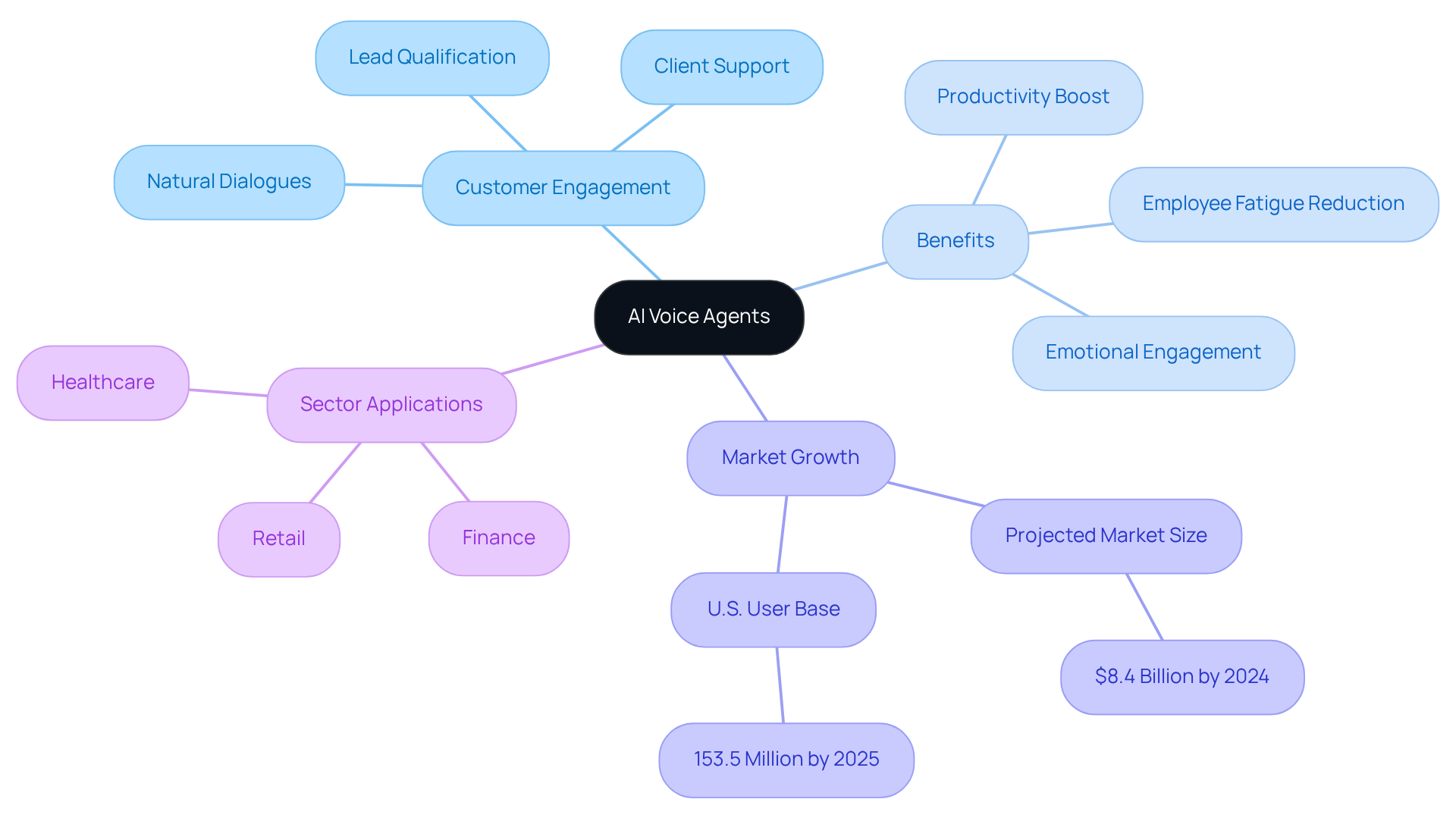
Chatbots: Deliver Instant Support and Personalized Interactions
Chatbots have emerged as indispensable tools in retail AI, delivering immediate assistance to customers around the clock. They proficiently manage frequently asked questions, facilitate product inquiries, and guide users through the purchasing journey. By leveraging retail AI, these chatbots tailor interactions based on user data, enabling them to offer personalized suggestions that resonate with individual preferences.
Consider a retail chatbot that analyzes a buyer's previous purchases to recommend complementary items. This capability significantly and creates additional sales opportunities. Personalized recommendations can boost conversion rates by an impressive 15-20%, highlighting the financial implications of such interactions. This swift assistance not only elevates customer satisfaction—evidenced by 80% of users reporting positive experiences with chatbots—but also alleviates the burden on human agents, allowing them to concentrate on more complex inquiries. Companies can achieve approximately 30% savings on support costs by implementing chatbots, presenting a compelling financial incentive for their adoption. Therefore, chatbots are pivotal in driving sales and enhancing overall customer engagement within the realm of retail AI.
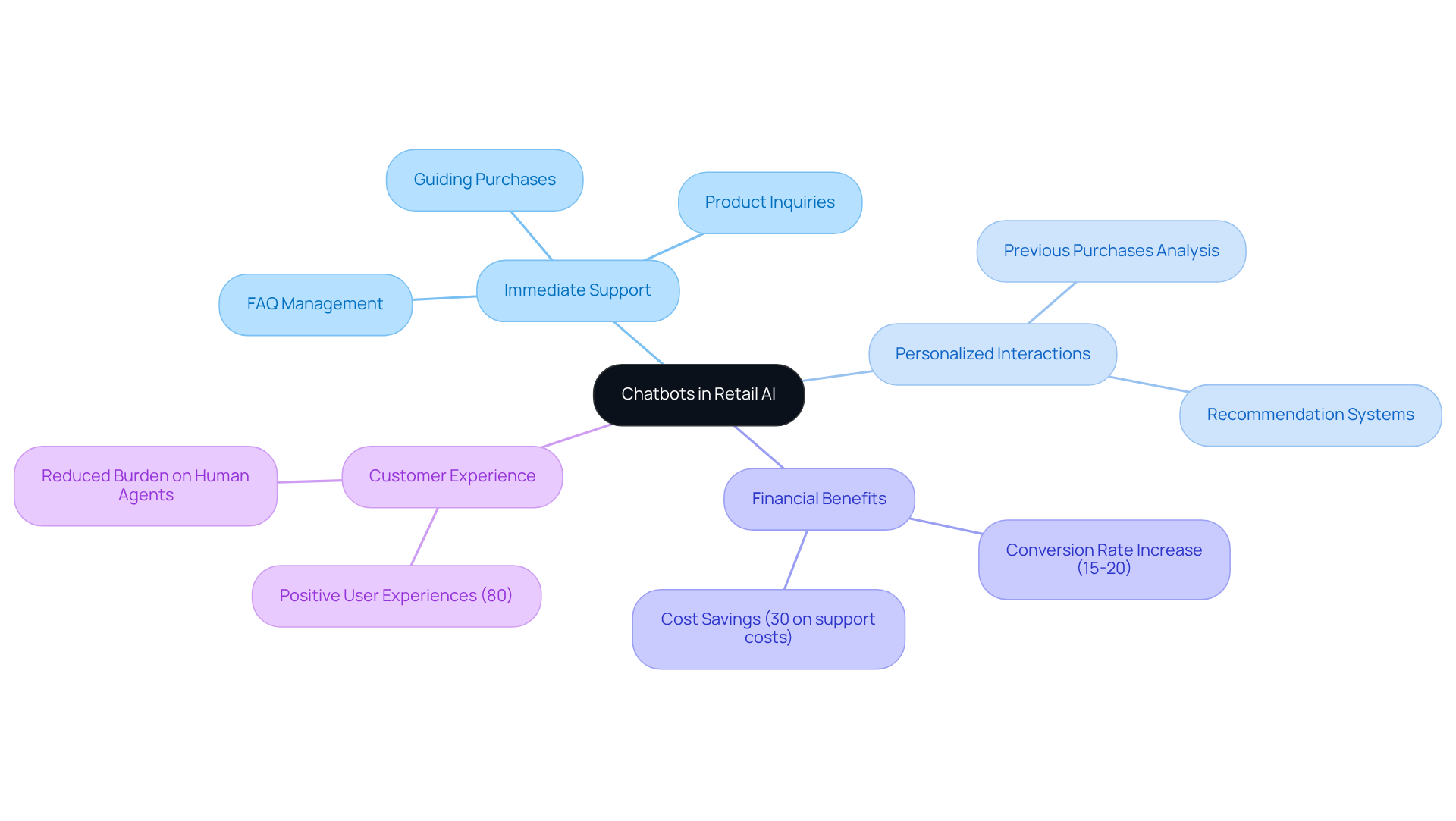
Predictive Analytics: Anticipate Customer Needs for Improved Satisfaction
Predictive analytics in retail AI harnesses historical data to forecast future consumer behaviors and preferences, empowering businesses to anticipate needs and tailor their offerings accordingly. By scrutinizing buying behaviors, retailers can identify trends, such as an individual's inclination toward seasonal products, and proactively deliver targeted promotions or reminders as relevant seasons approach.
This proactive approach not only elevates but also increases the likelihood of repeat purchases, as clients feel acknowledged and valued. For instance, companies that effectively implement predictive analytics have reported significant improvements in client engagement, with research indicating that personalization can lead to an 8% increase in conversion rates. Moreover, businesses leveraging these insights can anticipate up to 25% revenue growth, underscoring the financial advantages of adopting such technologies.
Retailers like Starbucks exemplify this strategy by employing retail AI for predictive personalization to tailor promotions based on consumer needs, resulting in enhanced engagement and loyalty. In fact, 90% of consumers favor platforms that provide personalized services, underscoring the importance of predictive analytics in meeting client expectations. As client expectations continue to escalate, those who leverage predictive analytics will not only refine their sales strategies but also foster deeper connections with their clients, ultimately driving sustained success.
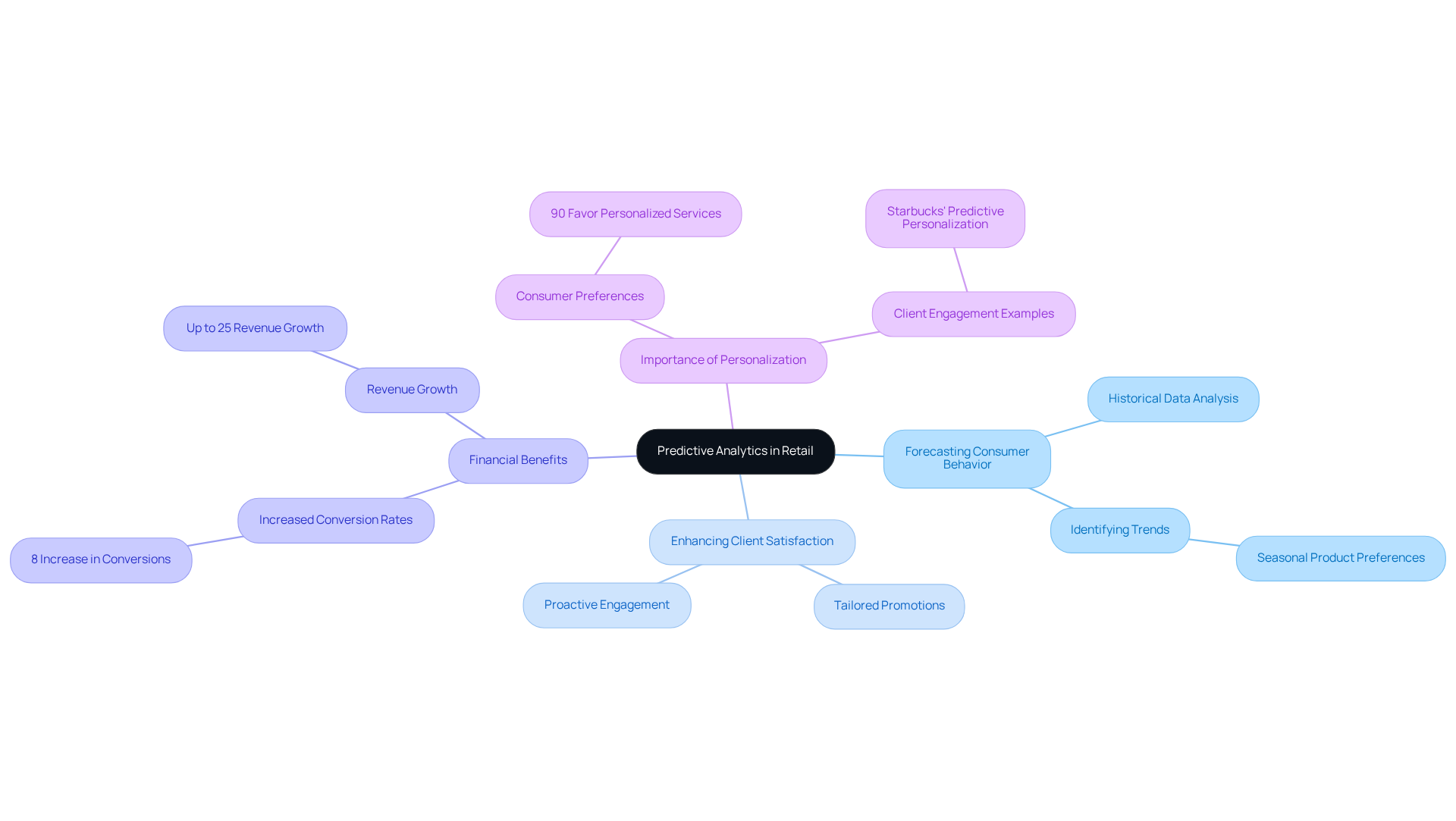
Personalization Engines: Tailor Recommendations to Individual Preferences
Personalization engines leverage client data to deliver tailored recommendations, significantly enhancing the shopping experience. By analyzing personal preferences, retailers can suggest products that resonate with a client's interests, thereby boosting conversion rates.
For example, e-commerce platforms utilize these engines to recommend items based on a user's browsing history and previous purchases. This level of customization not only elevates client satisfaction but also cultivates loyalty; a striking 64% of consumers favor shopping with brands that offer , underscoring the growing demand for tailored interactions in retail.
Retailers such as Amazon exemplify this strategy, employing AI to personalize product recommendations, which can lead to an increase of up to 40% in purchases. As a result, clients are more inclined to return to merchants that acknowledge their unique preferences, ultimately enhancing revenue performance and client retention.
For companies that master personalization, the advantages are clear: increased revenue, strengthened brand loyalty, and a competitive edge in the marketplace. Therefore, consider implementing a personalization strategy to boost client engagement and drive sales.
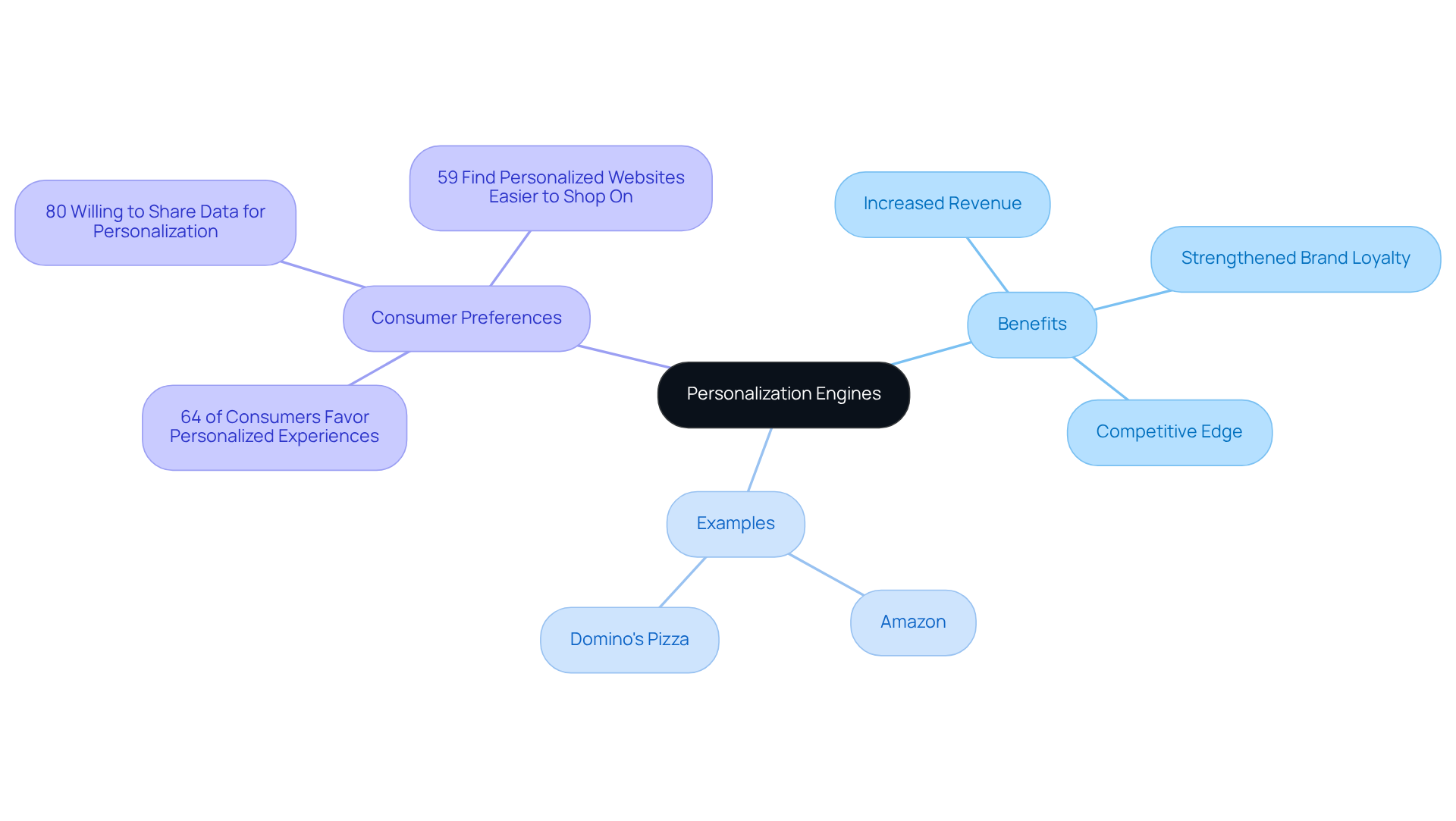
Visual Search: Simplify Product Discovery with Image Recognition
Visual search technology is revolutionizing the way users discover products by allowing them to search using images rather than words. This innovative approach streamlines product discovery, empowering users to upload a photo of an admired item and find similar products available for purchase.
For example, a shopper may capture an image of a dress seen on social media and utilize visual search to locate it on a retailer's website. This capability not only enhances the shopping experience but also significantly boosts conversion rates, as shoppers can quickly find desired items without the frustration of extensive searching.
Retailers leveraging retail AI and image recognition technology have reported improved customer engagement and increased revenue, demonstrating the effectiveness of visual search in modern e-commerce. Recent studies indicate that implementing visual search has led to surpassing daily KPIs, including revenue, underscoring its impact on driving income.
As industry experts assert, "Visual search not only simplifies the shopping experience but also aligns with consumer preferences for quick and efficient product discovery.
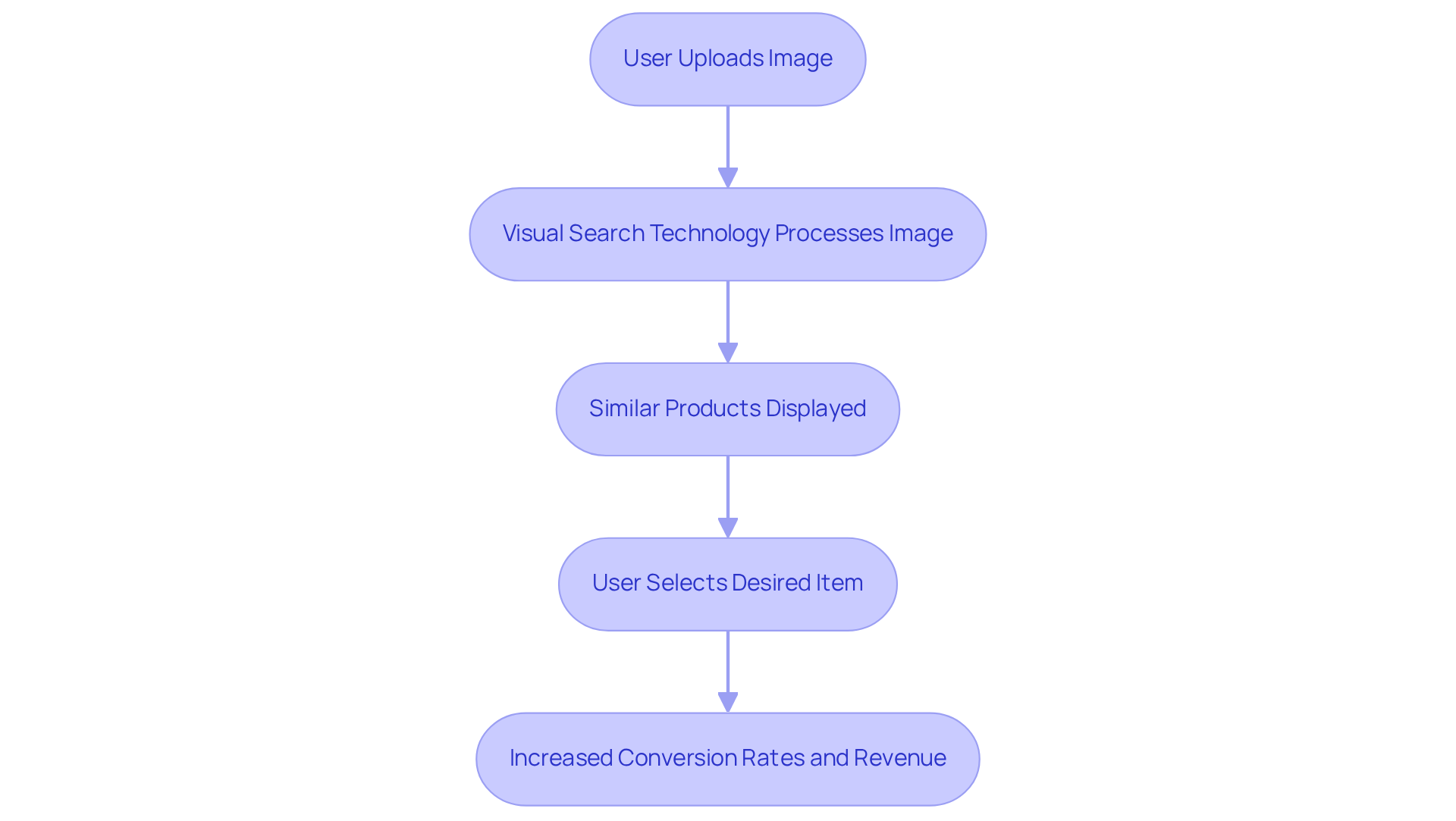
Inventory Management AI: Optimize Stock Levels for Better Availability
AI-driven inventory management systems leverage advanced analytics to scrutinize sales data and market trends, empowering businesses to optimize stock levels with precision. By accurately forecasting demand, these systems guarantee the availability of high-demand items while minimizing surplus inventory. For instance, an AI solution can notify merchants when stock levels dip for popular products, facilitating timely reordering. This proactive approach not only elevates client satisfaction by averting stockouts but also enhances operational efficiency by reducing carrying costs associated with excess inventory.
As industry experts assert, optimizing stock levels through retail AI technology is vital for sustaining a competitive advantage in today's retail environment. As Global Intec aptly states, 'Inventory is Money Sitting Around in Another Form,' underscoring the necessity of effective stock management. Moreover, the adaptability of AI solutions is exemplified in Heineken's enhanced trade promotion forecasts, illustrating the tangible advantages of integrating AI into inventory management.
To further bolster effectiveness, businesses should contemplate implementing low-stock alerts and utilizing inventory software with , as these practices can significantly refine decision-making and operational efficiency.
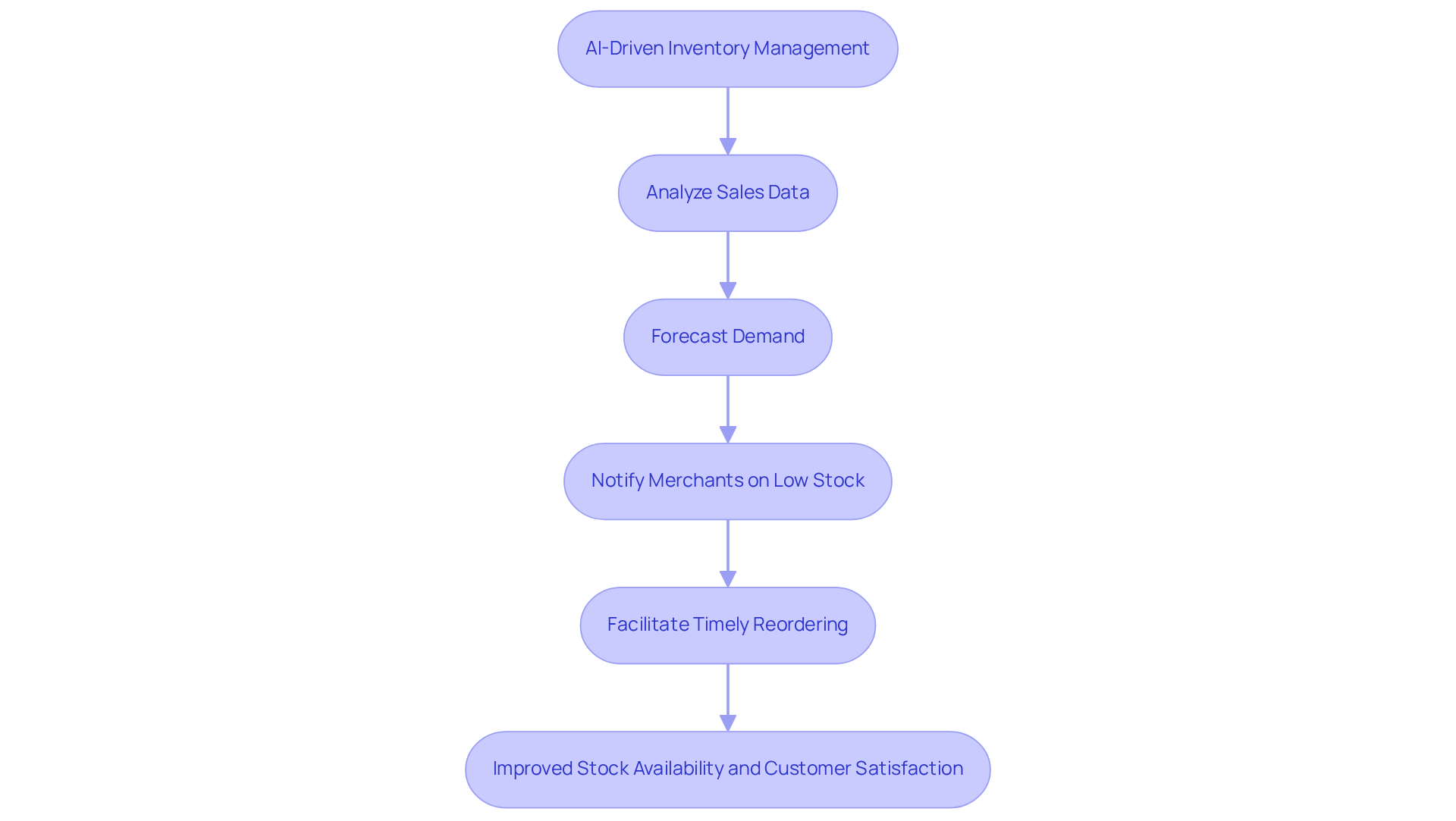
Dynamic Pricing: Adjust Prices in Real-Time for Competitive Advantage
Dynamic pricing empowers sellers to adjust prices in real-time, responding to factors such as demand fluctuations, competitor pricing, and buyer behavior. This not only maximizes revenue but also ensures competitiveness in a rapidly evolving market.
For instance, during peak shopping seasons, sellers may increase prices on high-demand items while simultaneously providing discounts on slower-moving products. This adaptability enhances profitability and improves client engagement, as shoppers are more inclined to make purchases when they perceive they are receiving a favorable deal.
Notably, large merchants like Kroger and Walmart have effectively adopted retail AI-driven dynamic pricing techniques, illustrating how these adjustments can lead to improved buyer experiences and increased revenue. In fact, sellers employing real-time pricing modifications have reported significant enhancements in conversion rates, underscoring the effectiveness of this approach in boosting sales and fostering client loyalty.
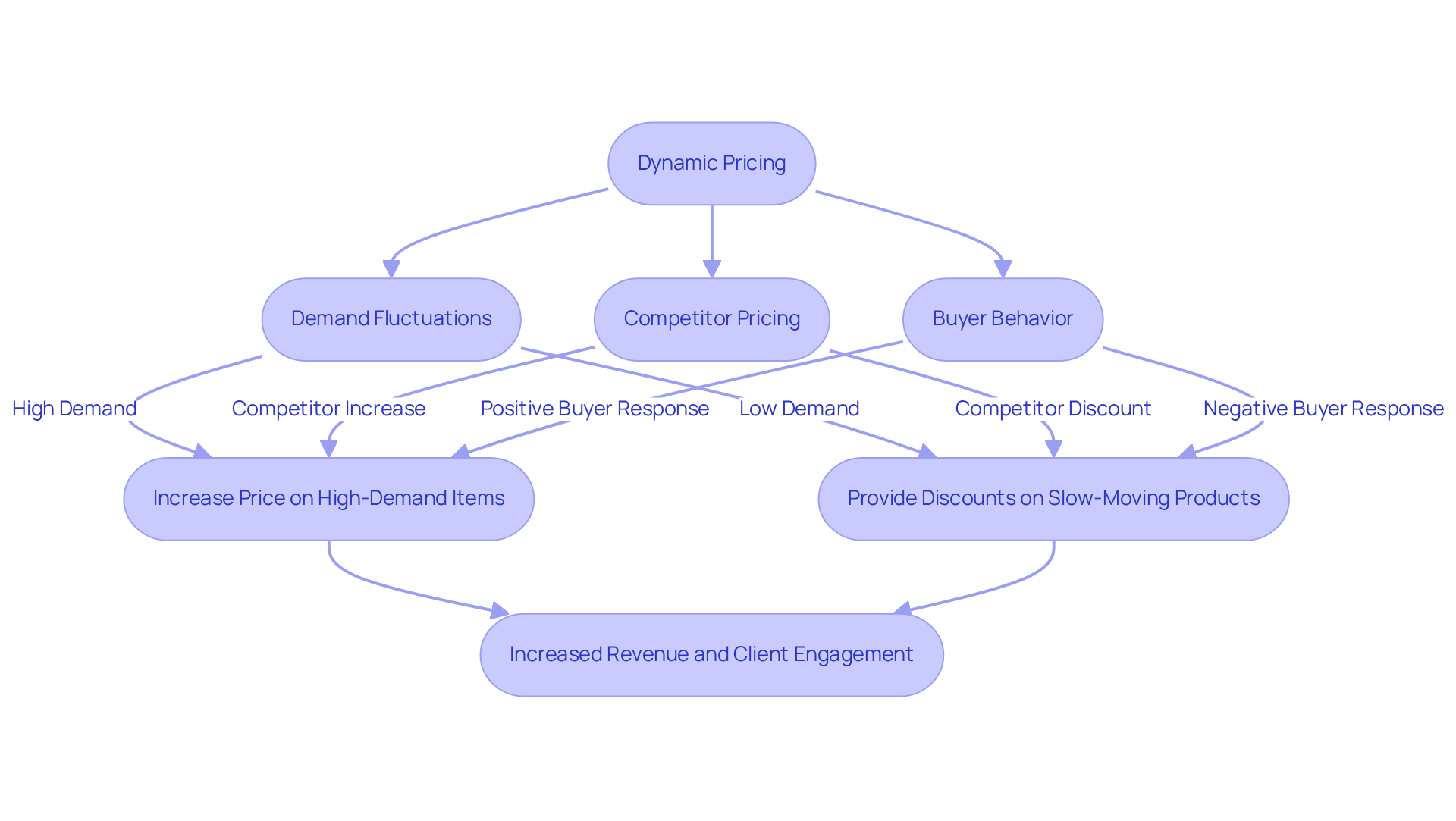
Sentiment Analysis: Understand Customer Emotions for Proactive Engagement
Sentiment analysis employs AI to examine feedback, reviews, and social media interactions, assessing user emotions. Understanding customer sentiments about their experiences enables businesses to proactively address concerns and enhance engagement strategies.
With Intone's , the implementation and personalization process becomes straightforward, allowing businesses to customize interactions based on real-time insights and intelligent analytics. The editor facilitates sellers in uploading scripts and training materials, ensuring that the AI assistant is specifically tailored to their business requirements.
Furthermore, the telephony setup enables seamless call forwarding to the Intone agent or the use of a built-in dialer. For instance, if sentiment analysis reveals negative feedback regarding a particular product, sellers can promptly resolve the issue by enhancing product quality or improving service.
This proactive strategy not only boosts client satisfaction but also fosters loyalty, as clients appreciate businesses that actively listen to and address their concerns.
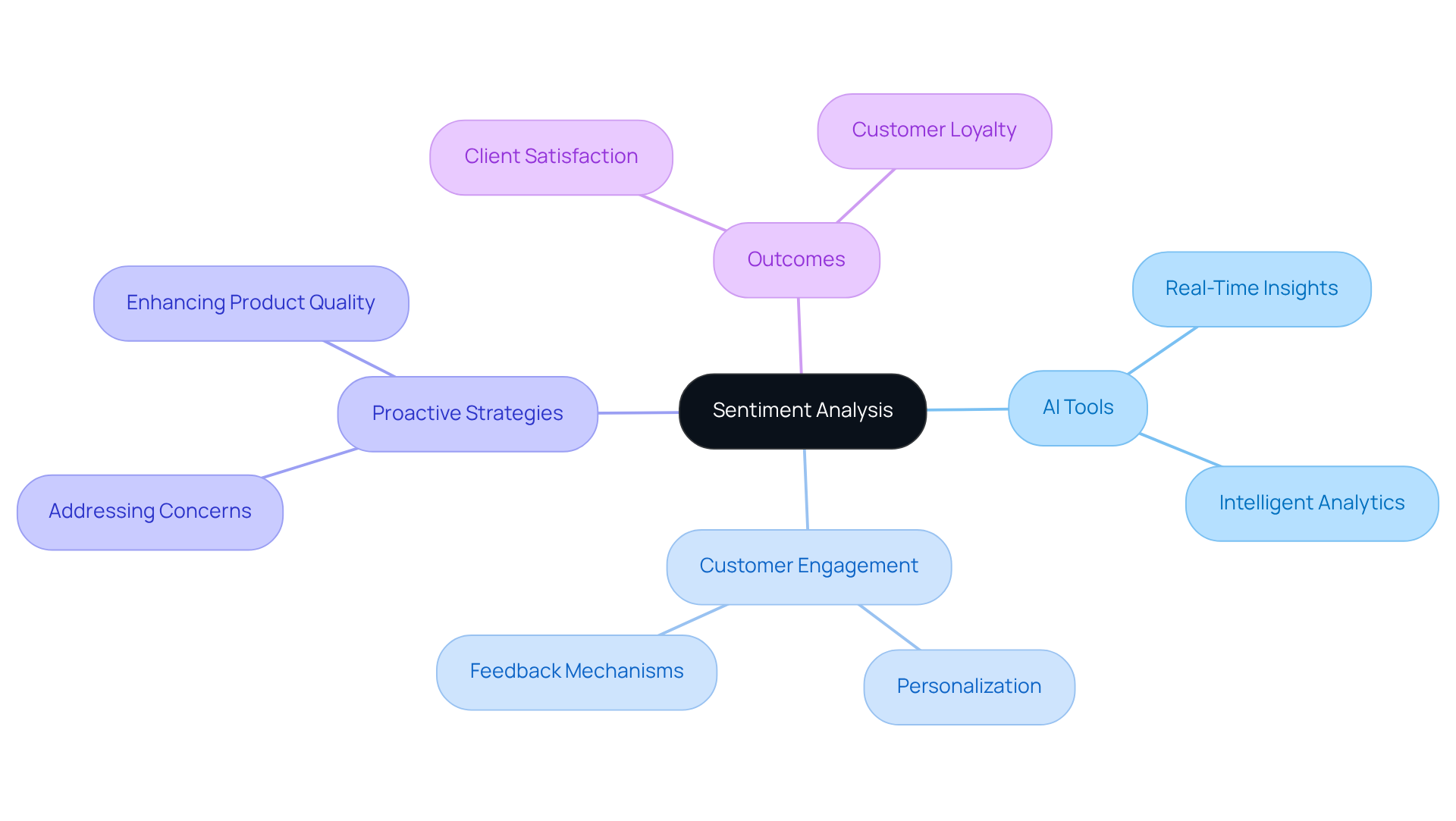
Omnichannel Solutions: Create a Seamless Shopping Experience Across Platforms
Omnichannel solutions, powered by retail ai, empower businesses to create a seamless shopping experience across various platforms—online, mobile, and in-store. By integrating these channels with Intone's adaptable AI vocal assistants, businesses can deliver a uniform experience, regardless of how clients choose to shop. Intone's AI agents are customizable to meet specific business needs, utilizing uploaded scripts and training resources to enhance client interactions.
Consider a shopper who explores products on a merchant's website, adds items to their cart, and later finalizes the transaction in-store. With , businesses can establish data sources, implement call transfer guidelines, and generate post-call reports, ensuring that client inquiries are managed effectively across all channels. This level of integration not only enhances client satisfaction but also amplifies sales opportunities, as consumers are more inclined to engage with retailers that utilize retail ai to offer a cohesive shopping experience backed by real-time performance insights. Furthermore, the availability of 24/7 AI agents ensures constant assistance for clients, significantly improving their shopping experience.
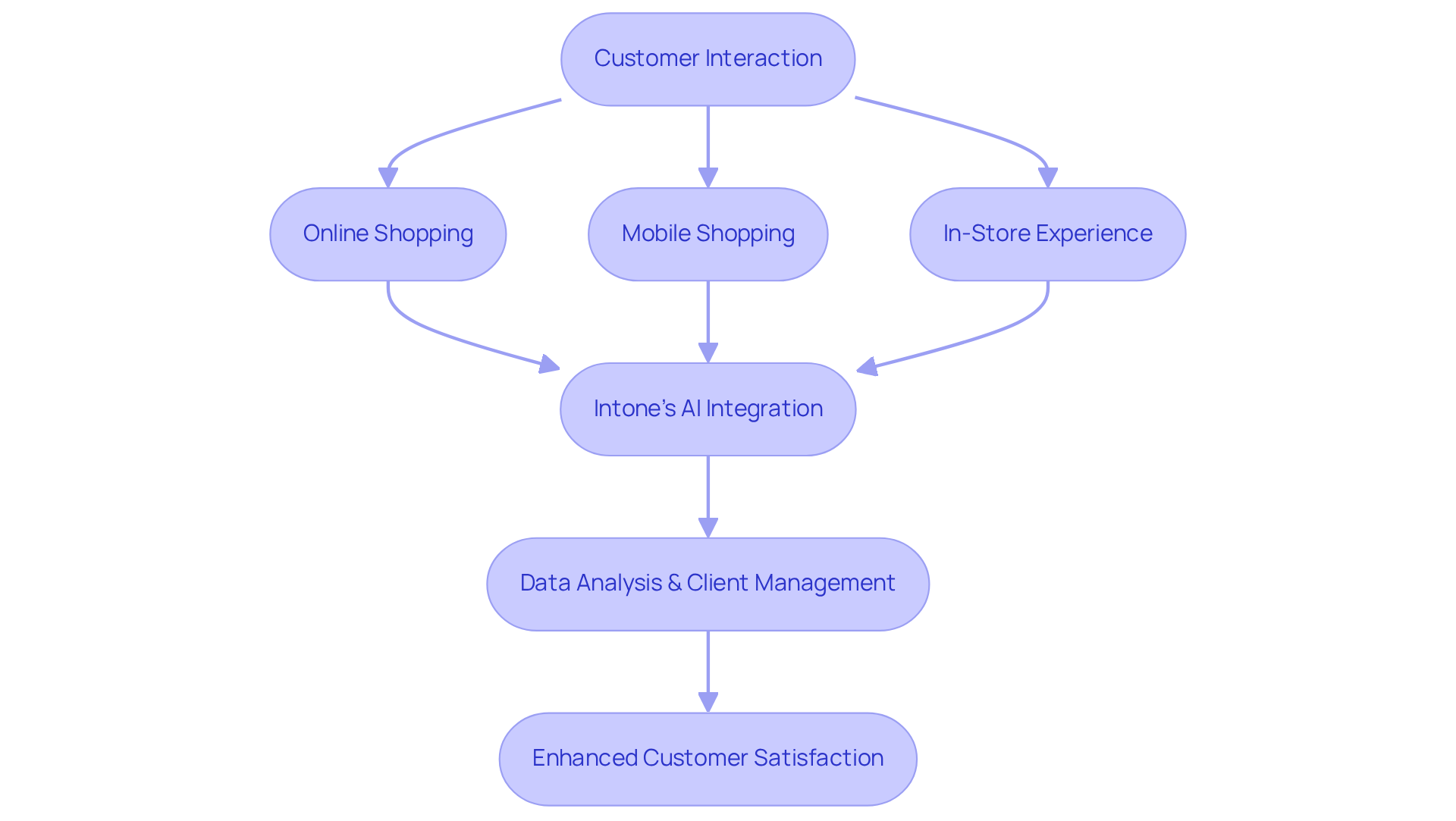
Loyalty Programs: Use AI to Enhance Customer Retention Strategies
AI plays a crucial role in enhancing loyalty programs by utilizing client data to create personalized rewards and incentives. By examining individual preferences and buying habits, businesses can develop loyalty programs that resonate with their clients. For instance, retailers can offer exclusive discounts or rewards tailored to a shopper's purchasing history, which not only encourages repeat purchases but also fosters a deeper sense of loyalty. As noted, "Personalized recommendations, targeted marketing, and understanding client preferences lead to better satisfaction and loyalty."
The effectiveness of personalized rewards is underscored by statistics indicating that 51.05% of consumers are likely to remain loyal to brands that provide convenient and valuable loyalty rewards. This statistic highlights the significance of personalized rewards in promoting client retention. Furthermore, leading brands are 39% more likely to leverage AI to adjust messaging based on real-time interactions, thereby enhancing user engagement.
Starbucks exemplifies this approach through its Rewards program, which gamifies the experience by offering personalized offers and complimentary items based on individual preferences. This strategy has markedly boosted client loyalty and engagement, illustrating the of personalized rewards in retail AI loyalty programs. By concentrating on individual customer needs, retailers can not only elevate satisfaction but also drive long-term engagement and retention.
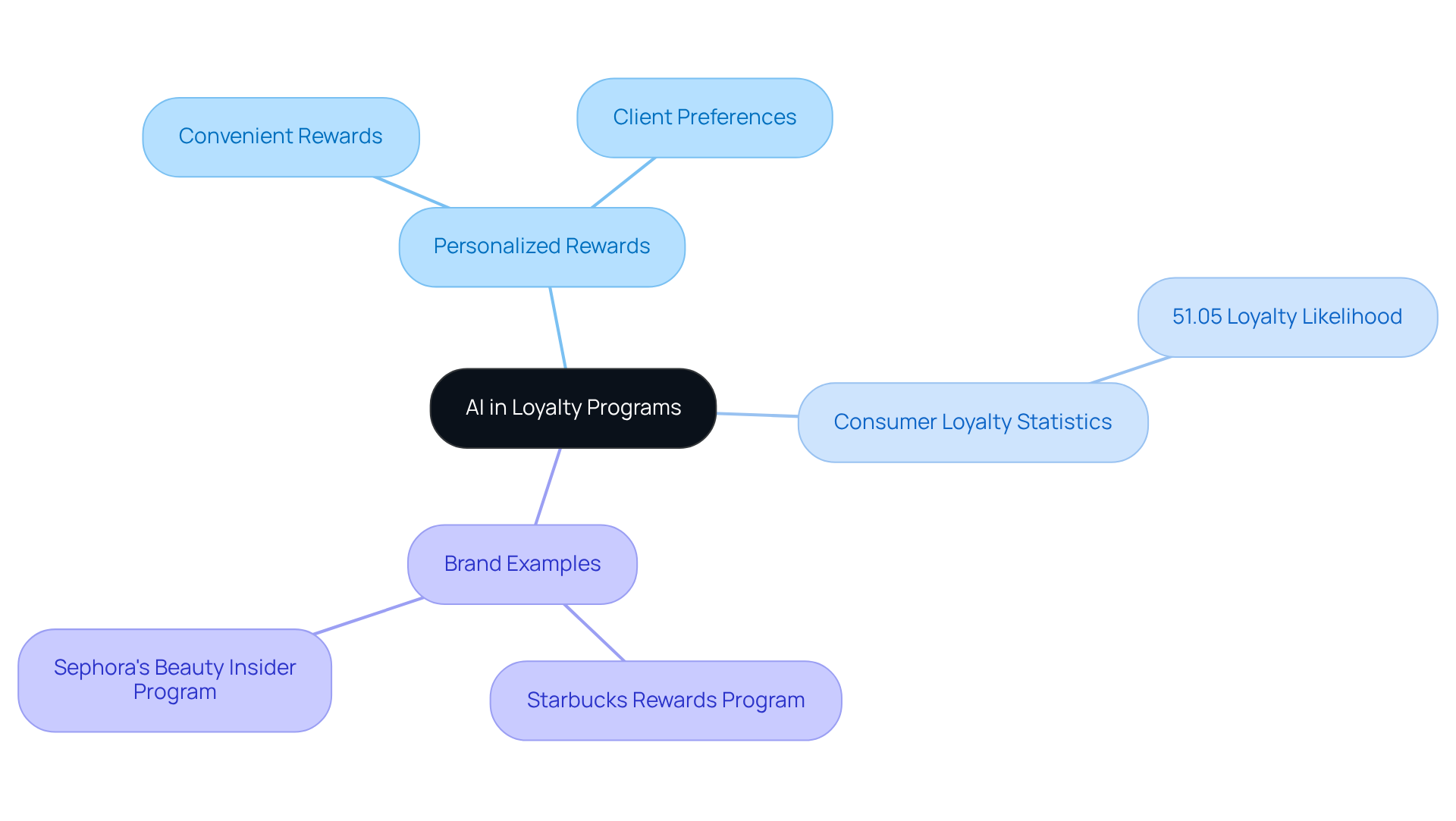
Conclusion
The exploration of retail AI innovations unveils a transformative landscape where technology significantly enhances customer engagement and drives sales. By integrating advanced AI solutions, businesses can craft personalized experiences, streamline operations, and proactively respond to consumer needs. These innovations not only elevate client satisfaction but also position retailers to thrive in an increasingly competitive market.
Key insights from this article underscore the effectiveness of AI voice agents, chatbots, predictive analytics, and personalization engines in fostering deeper connections with customers. Technologies such as visual search and dynamic pricing further exemplify how AI can simplify product discovery and optimize revenue strategies. Moreover, implementing sentiment analysis and omnichannel solutions enables businesses to grasp customer emotions and deliver a seamless shopping experience, ultimately enhancing loyalty programs and retention strategies.
In a rapidly evolving retail environment, embracing these AI innovations is imperative for success. Retailers are urged to leverage these technologies not merely as tools for operational efficiency but as integral components of a customer-centric strategy. By doing so, businesses can not only meet but exceed consumer expectations, ensuring sustained engagement and loyalty in the years to come.
Frequently Asked Questions
What is Intone and how does it enhance customer engagement?
Intone is an AI voice assistant that facilitates smooth, natural dialogues to enhance customer engagement and drive revenue. It manages responsibilities like lead qualification and client support, optimizing interactions for conversion.
How do AI voice assistants perform in the finance sector?
In the finance sector, AI voice assistants excel at following up on overdue payments and promoting products, achieving conversion rates that surpass traditional methods.
What benefits do Intone's AI voice assistants provide to businesses?
Intone's AI voice assistants boost productivity, alleviate employee fatigue by automating repetitive tasks, and provide real-time analytics to evaluate performance.
What emotional skills do AI voice assistants possess?
AI voice assistants are recognized for their emotional engagement skills, including heightened attention, empathy, and patience, which are essential for nurturing deeper client relationships.
What is the projected growth of the global AI voice assistant market?
The global AI voice assistant market is projected to reach $8.4 billion by the end of 2024, with the U.S. user base expected to grow to 153.5 million in 2025.
How do chatbots contribute to customer support in retail?
Chatbots deliver immediate assistance to customers 24/7, managing FAQs, facilitating product inquiries, and guiding users through the purchasing journey.
How do chatbots personalize customer interactions?
Chatbots leverage retail AI to tailor interactions based on user data, allowing them to offer personalized suggestions that resonate with individual preferences.
What impact do personalized recommendations from chatbots have on sales?
Personalized recommendations can boost conversion rates by 15-20%, creating additional sales opportunities and enhancing the shopping experience.
What financial benefits do companies experience by implementing chatbots?
Companies can achieve approximately 30% savings on support costs by implementing chatbots, making them a financially compelling option.
What role does predictive analytics play in retail AI?
Predictive analytics uses historical data to forecast future consumer behaviors, allowing businesses to anticipate needs and tailor offerings, which enhances client satisfaction.
How does predictive analytics improve customer engagement?
By proactively delivering targeted promotions based on identified trends, predictive analytics elevates client satisfaction and increases the likelihood of repeat purchases.
What are the reported benefits of companies using predictive analytics?
Companies that effectively implement predictive analytics report significant improvements in client engagement, with an 8% increase in conversion rates and potential revenue growth of up to 25%.
How do companies like Starbucks utilize predictive analytics?
Starbucks employs retail AI for predictive personalization to tailor promotions based on consumer needs, resulting in enhanced engagement and loyalty.
Why is predictive analytics important for meeting client expectations?
Predictive analytics is crucial as 90% of consumers prefer platforms that provide personalized services, helping businesses meet escalating client expectations and foster deeper connections.






